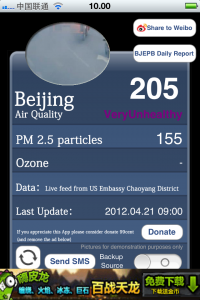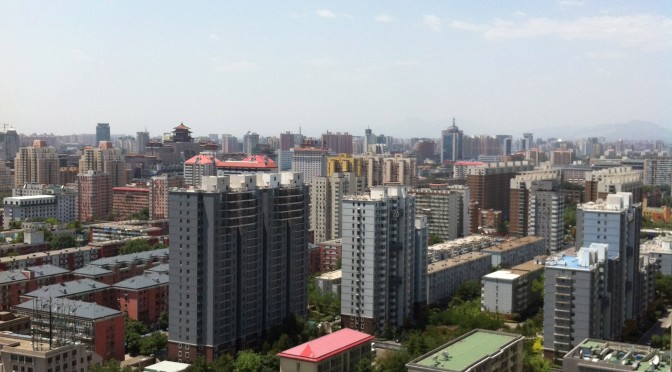 Today is yet another day in Beijing with gray sky and “Very unhealthy” air quality, at least according to the measurement from the US Embassy in Beijing (see the screen dump from my phone). But the Beijing Government is now acting on the bad situation.
Today is yet another day in Beijing with gray sky and “Very unhealthy” air quality, at least according to the measurement from the US Embassy in Beijing (see the screen dump from my phone). But the Beijing Government is now acting on the bad situation.
In February the local government launched its plan for air quality improvement measures to be implemented this year in Beijing, as referred in China Daily. The city will cut PM 2.5 levels by 15 percent by 2015 compared with 2010 levels, and cut overall air pollution levels by 30 percent over the same period.
The plan includes the following items:
- By the end of the year, the city will complete a network of 35 PM2.5 monitoring stations and establish a satellite remote sensing system to oversee the overall air condition.
- By 2020, 1.6 million old automobiles designed with outdated emission standards will be weeded out.
- By 2020, the government is expected to limit the city’s annual total consumption of coal within 10 million tons, 62 percent less than the amount estimated to be consumed by the end of 2015.
- From now on, heavy-polluting and energy-consuming companies in oil refining, petrochemical, cement, iron and steel industries will not be allowed to open new plants or expand their current workplaces. By 2015, 1,200 factories producing asphalt, glass and ceramic will retreat from the city. By 2020, all cement plants run for profit in Beijing will be closed.
- By 2020, the city will increase its forest area by 2 million mu (133,000 hectares) and increase water surface by 2,000 hectares, in an effort to improve the city’s environmental carrying capacity.
In March the measures were further explained in China Daily by Zhang Gong, head of the municipal Development and Reform Commission:
- As vehicle exhaust accounts for 22.2 percent of the total emissions of PM 2.5, fine particulate matter 2.5 microns or less in diameter, Beijing attaches great importance to the development of public transportation and by 2015, a total of 660 km of metro lines should be in service,
- A subsidy scheme will be issued to encourage consumers to buy new energy vehicles.
- In addition, the city aims to cap its annual coal consumption at 15 million tons by 2015, by replacing coal used in coal-fired power plants with natural gas. At present, the coal consumption of coal-fired power plants in Beijing is 8.8 million tons a year.
In spite of the good intentions quite a lot Beijingers would think that the plan is too little and too late, taking the current bad situation into account.
Luckily it is likely that a new initiative will further promote the efforts to improve the air quality in Beijing. Earlier this year the National Development and Reform Commission announced it would launch carbon-trading systems next year in five cities – Beijing, Tianjin, Shanghai, Shenzhen and Chongqing, as well as in Guangdong and Hubei provinces. Beijing is now preparing for setting up the test trading system next year, according to a recent article in China Daily. The system will include both energy producers and energy consumers and will push for a substitution of coal with natural gas which has a lower content of CO2. More than 600 companies and industries with a carbon emission of more than 10,000 tons per year will be included in the trading system. An overall target for the quotas has not been fixed yet; it will be linked to city’s target to lower its carbon intensity – the amount of emissions per unit of GDP produced – by 18 percent during the 12th Five-Year Plan (2011-15).
The implementation of the test trading system in the five cities and two provinces is an important step towards a more general CO2 quota system in China. Experiences from Europe show that a trading system is difficult to manage and might have the opposite impact if not set up correct and fine-tuned to changing circumstances. It shall be interesting to follow the implementation in Beijing – hopefully with utilisation of the European experiences to avoid the pitfalls and hopefully with many more “Blue-sky” days in Beijing as result. I am looking forward to be able to go by bike to work without using a mouth filter to survive!
UPDATE 11.06.2012:
The pollution in Beijing is now being discussed on ing.dk (in Danish of course) so I would contribute with a couple of pictures from Beijing today where the pollution is very low and the sky is very blue :-).
Apparently senior officials from the Ministry of the Environment find the US Embassy measurements illegal. Read more here.







